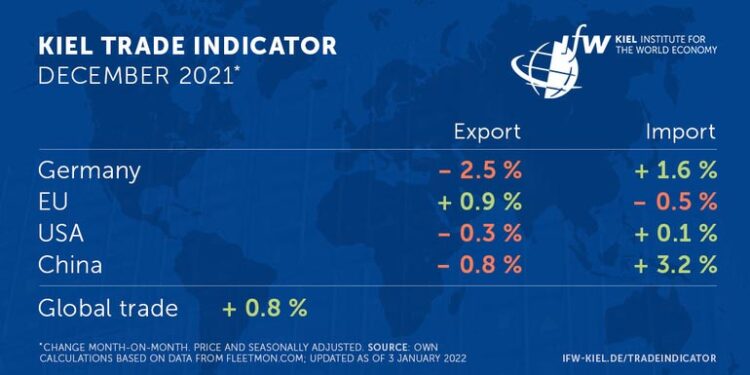World trade unimpressed by Omicron so far

Kiel Trade Indicator 12/2021:
Kiel Trade Indicator, Update January 5,2022: In contrast to the first major wave of the pandemic, world trade has so far not shown any negative swings in the face of the Omicron variant rampant in many countries. Following the latest data update, the Kiel Trade Indicator signals a slight increase in global trade (0.8 %). Overall, however, the single indicators continue to show a mixed picture for trade flows. A strong catch-up process is not visible in the data. Large volumes of goods can still only be handled with delay at the seaports.
For Germany, the indicator for December 2021 signals a slightly negative export trend at – 2.5 percent, while imports remain on a slight upward trajectory at 1.6 percent. For the entire EU, the signs are reversed (exports +0.9 %, imports -0.5 %), but the values are within a range that indicates stagnation.
After negative signs for China’s trade in previous months, the Kiel Trade Indicator for December shows a sideways movement. When interpreting the figures from China, the normally high fluctuations in monthly values there must be taken into account.
According to the Kiel Trade Indicator, changes in US imports and exports are close to zero. However, there are signs of a positive development at the American ports: After the Christmas shopping season, the pressure on the ports of Los Angeles and Savannah appears to be easing slightly, and ship congestion is reducing there. However, with about 11 percent of shipped goods still trapped in stalled vessels, congestion only seems to be shifting to other ports and areas.
“As previously expected, there are no clear signs of any catch-up effects in world trade around the turn of the year. We will probably have to wait at least until after the Chinese New Year for a normalization of sea freight traffic. Particular attention must be paid to Chinese ports. Should China again react drastically with port closures to new Covid19 cases, this could again put supply chains under stress,” said Vincent Stamer, Head of Kiel Trade Indicator, on the occasion of the latest data update.
The volume of cargo in the Red Sea, an important indicator for European-Asian trade, approached its expected level for the month in December, but is currently around 11 percent below it again.
The next Kiel Trade Indicator updates will be on January 20 (without media information) and February 7 (with media information for January 2022 trade data).
Further information on the Kiel Trade Indicator and the forecasts for individual countries and regions can be found on the KTI webpage (https://www.ifw-kiel.de/topics/international-trade/kiel-trade-indicator/).
About the Kiel Trade Indicator
The Kiel Trade Indicator estimates trade flows (imports and exports) of 75 countries worldwide, the EU, and world trade as a whole. Specifically, the estimates cover over 50 individual countries as well as regions such as the EU, sub-Saharan Africa, North Africa, the Middle East, or emerging Asia. It is based on the evaluation of ship movement data in real time. An algorithm programmed at the Kiel Institute uses artificial intelligence to analyze the data and translates the ship movements into seasonally adjusted growth figures compared with the previous month.
We update the data twice a month. Around the 20th (without media release) for the current and the following month and around the 5th (including media release) for the previous and the current month.
Arriving and departing ships are recorded for 500 ports worldwide. In addition, ship movements in 100 maritime regions are analyzed and the effective utilization of container ships is derived from draught information. Country-port correlations can be used to generate forecasts, even for countries without their own deep-sea ports.
Compared to other leading trade indicators, the Kiel Trade Indicator is available much earlier, is much more comprehensive, relies on a uniquely large database using big data, and has a low statistical error by comparison. The algorithm of the Kiel Trade Indicator uses machine learning, so that the quality of the forecast continues to improve over time.
Media Contact:
Guido Warlimont
Head of Communications
T +49 431 8814-629
guido.warlimont@ifw-kiel.de
Kiel Institute for the World Economy
Kiellinie 66 | 24105 Kiel | Germany
T +49 431 8814-774
F +49 431 8814-500
www.ifw-kiel.de
Wissenschaftliche Ansprechpartner:
Vincent Stamer
Presidential Task Force,
Trade Policy Task Force
T +49 431 8814-228
vincent.stamer@ifw-kiel.de
Media Contact
All latest news from the category: Business and Finance
This area provides up-to-date and interesting developments from the world of business, economics and finance.
A wealth of information is available on topics ranging from stock markets, consumer climate, labor market policies, bond markets, foreign trade and interest rate trends to stock exchange news and economic forecasts.
Newest articles

A blueprint for mapping melting ice sheets
Researchers in the Stanford Radio Glaciology lab use radio waves to understand rapidly changing ice sheets and their contributions to global sea-level rise. This technique has revealed groundwater beneath Greenland,…

Water hyacinth plant pots – utilization of an invasive species
Together with Fiber Engineering GmbH, the DITF presents a process for the production of biodegradable plant pots. The products are cost effective and competitive. At the same time, the production…

Current research on the new 6G mobile communications standard
Nursing care robots, autonomous driving, digital twins: all of these high-tech applications will play an essential role for the new 6G mobile communications standard. The first commercial 6G networks are…



